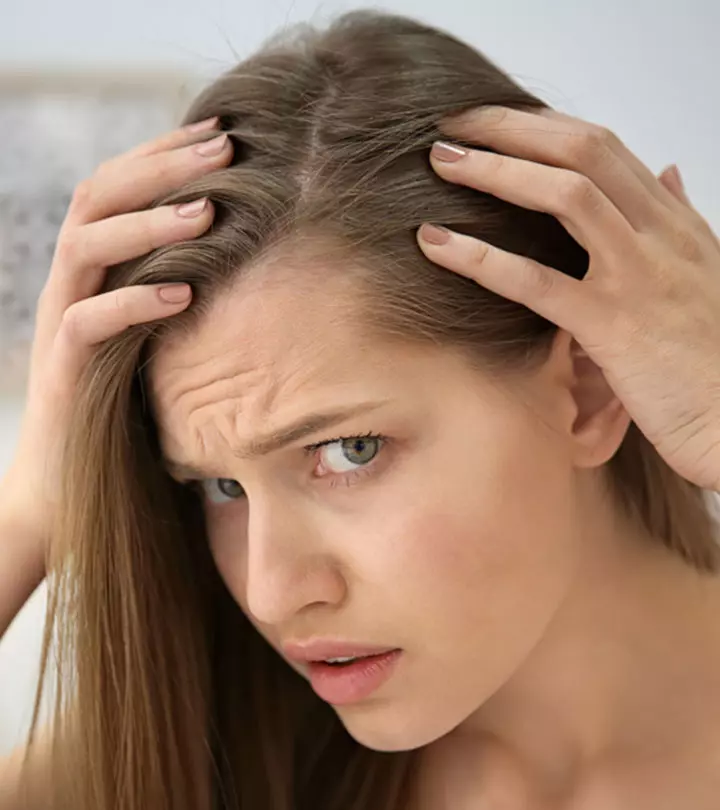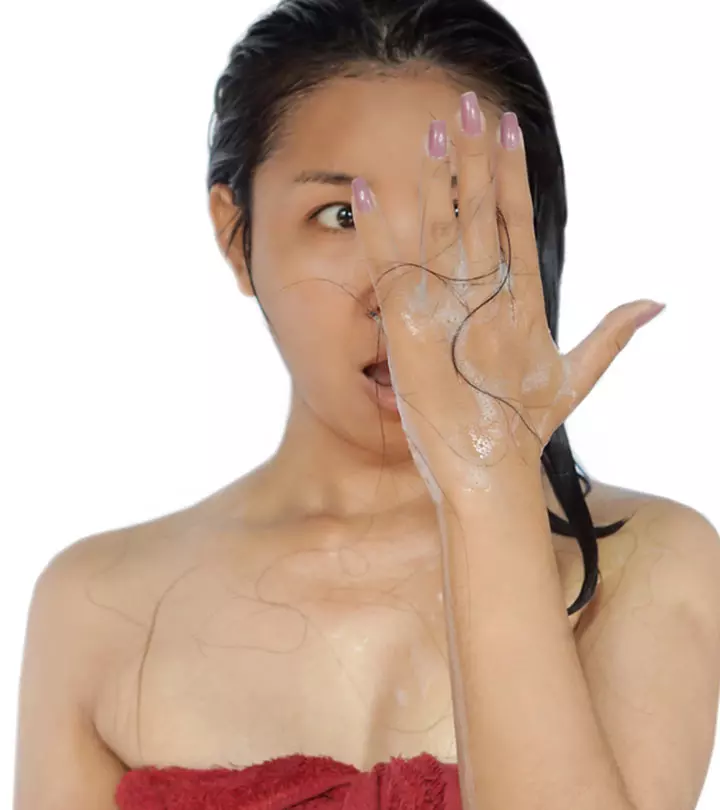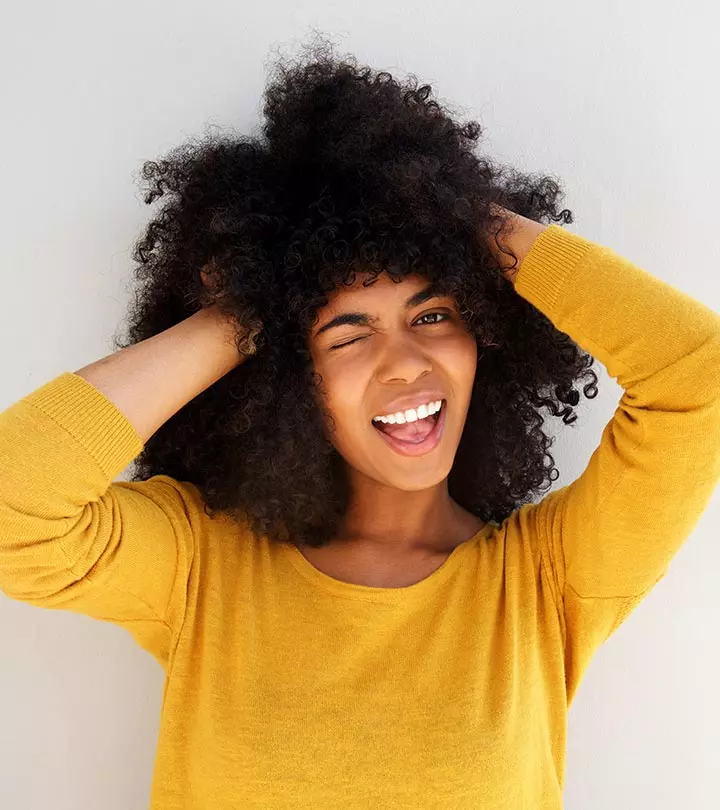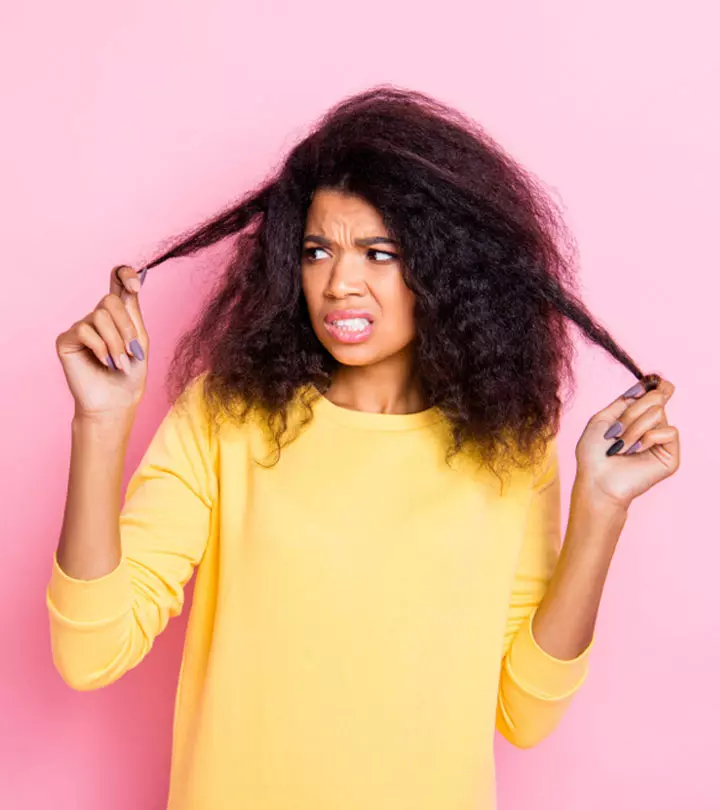Traumatic Alopecia: Symptoms, Causes, And Prevention Tips
Find out how your favorite hairstyle may cause hair loss and what to do about it.

There is a possibility that your favorite hairstyle may cause hair loss. Styling your hair in tight buns, ponytails, and braids can pull on your hair follicles and cause a condition called traumatic alopecia.
Traumatic alopecia, also known as traction alopecia, is a common form of hair loss that occurs over a period of time. It is caused by wearing tight hairstyles. Keep reading this article to know more about the causes and symptoms of traumatic alopecia and the treatment and prevention options available.
In This Article
What Is Traumatic Alopecia?
Alopecia, in general, is the medical term for loss of hair. But, it can occur in different forms. Traumatic or traction alopecia is a specific form of acquired hair loss that results mainly from extended or repetitive tension on the scalp.
The chances of developing traumatic hair loss are more if there is a forceful extraction of hair or the breaking of hair shafts by pressure, traction, friction, or any other physical trauma (1).
There are different types of hair loss caused by different reasons. It is essential to know the causes of this condition to effectively deal with traumatic hair loss. Its causes are discussed in the next section.
Key Takeaways
- Styling the hair in tight buns, ponytails, and braids can pull on hair follicles and cause traumatic alopecia, a condition that leads to hair loss.
- This condition is entirely reversible and the hair can regrow if it is identified and treated at an early stage.
- Avoid tight hairstyles or the same hairstyle for extended periods, overstyling or excessive heat treatments to treat and prevent traumatic alopecia.
What Is The Cause Of Traumatic Alopecia?
Traumatic alopecia is primarily caused by wearing the same hairstyle for extended periods, especially ones that tug on the hair, such as tight ponytails, braids, buns, cornrows, and heavy locks that cause hair trauma.
Gaby, a beauty content YouTuber, recounted her struggle with traction alopecia due to tight hairstyles and frequent extensions. She shared in her video, “When I was in my 20s, I used to love wearing my hair in very, very tight ponytails (i).” She added, “I loved it so much that I did it almost every single day.” This repeated tension caused hair follicle damage, leading to irreversible thinning.
Other causes of traumatic alopecia include:
- Excessive and repeated use of hair tools such as rollers or hot combs.
- Putting constant force on the hair or scalp surface and pulling that can cause loosening of the hair from the follicles.
Heavy use of hair relaxers or chemicals used to straighten hair.
- Repeated use of heavy hair extensions.
- Using extremely tight head covers such as caps or turbans that pull on your hair.
- Fluctuating hormone levels.
There is a wide variation in the pattern of symptoms, clinical presentation, and types of alopecia. Read the next section to find out more about it.
Symptoms Of Traumatic Alopecia
The early symptoms of traumatic alopecia include little bumps on the scalp that resemble pimples. However, as it progresses, the main symptom in most cases is hair fall or broken hair, especially on the front and sides of your scalp (2).
Apart from hair loss, other symptoms of traumatic or traction alopecia due to possible damage to hair follicles include (2):
- Soreness or stinging sensation on the scalp
- Itching and redness of the scalp
- Thinning of hair
- Receding hairline
- Broken hair or hair injury
- Folliculitis or inflammation of the hair follicles
- Extreme scaling of scalp skin
- Frequent headaches
- Blisters on the scalp
- Growth of vellus hair (peach fuzz) on affected areas
- Widening of hair parting
- Damaged and scarred hair follicles that are unable to produce new hair
- Can lead to telogen effluvium and diffuse hair loss
Now that you know the symptoms of traumatic alopecia, you must be wondering who is most likely to get affected by this condition. Read on to know more about it.
Who Gets Most Affected By Traumatic Alopecia?
In general, traumatic alopecia can impact people of all ages, both females and males. However, there are specific populations who are more affected by the condition due to differences in hair structure, hairstyles, and lifestyle factors.
For instance, hair loss after trauma (due to traction) is most common in adult women (2). A survey was conducted in the USA to evaluate the connection between post-traumatic stress disorder (PTSD) and hair loss where out of 1449 respondents, most were female (83.8%) and averaged 50.6 years. They had alopecia areata (AA) for an average of 17.7 years, and 91.4% were experiencing hair loss. Moreover, it underscores the mental health challenges linked to stress-induced hair loss, suggesting these symptoms may continue even after hair regrowth.
It is common among women with long hair who tie it up in tight hairstyles. Also, people who frequently wear wigs, tight hats, helmets, and people in specific professions that require them to pull their hair back, such as military personnel, ballerinas, gymnasts, and surgeons, are affected by this condition. People of African descent often suffer from this condition because their hair is generally curly, fragile, and tied tightly in protective hairstyles, which leads to breakage.
Wondering if you can prevent traumatic alopecia altogether or if there are any treatment options? Find out below.
Prevention Tips And Treatments For Traumatic Alopecia
Unlike other genetic forms of hair loss, traumatic alopecia can be treated. If identified and treated at an early stage, it is entirely reversible, and the hair can regrow. However, if left untreated, the hair follicles can soon become irreversibly damaged, leading to obstructed hair growth.
The treatment and the preventive measures after diagnosis both have a lot in common, so it is best to view them as a whole. Given below are preventative tips as well as treatment options for traumatic alopecia:
1. Avoid Tight Hairstyles
Since pulling of hair due to very tight hairstyles such as ponytails, braids, buns, and dreadlocks is the leading cause of traumatic alopecia, it is best to avoid such hairstyles. If you need to absolutely tie your hair up, make sure you keep it as loose as possible.
2. Limit The Use Of Heat-Styling Tools
Heat-based styling tools such as rollers, straightening irons, and curlers should be used only when absolutely necessary as they can cause irreversible damage to the hair follicles, leading to traumatic alopecia.
3. Try Different Hairstyles
Sporting just one hairstyle such as a parting down the middle of the same side for years can also lead to traumatic alopecia. To avoid putting too much pressure on specific parts of your scalp, make sure to change your hairstyle every few weeks.
 Quick Tip
Quick Tip4. Avoid Excessive Use Of Styling Products
Chemicals or other hair relaxers used for styles like perms or permanent straightening should be kept to a minimum as these styling gels or sprays can harden the hair, leading to increased hair tension and a higher risk of traumatic alopecia.
One of the best treatments for traumatic alopecia is to minimize the use of harsh chemicals on damaged strands of hair, as they can only worsen the condition. Opt for plant-based cosmetics or remedies instead to protect your hair from harmful chemicals.
5. Keep The Use Of Hair Accessories To A Minimum
Hair extensions and accessories can pull on your natural hair and increase tension on your scalp. It is, therefore, recommended to wear hair accessories only when necessary or try to use them in different styles. Allow your hair to rest, and try to avoid the use of clips, bands, and clutches on a frequent basis. Also, explore different hairstyles every few days to prevent unnecessary strain on any area of your scalp.
 Quick Tip
Quick Tip6. Choose The Right Wigs
If you are using hair wigs, make sure to pick one that has a base made of a material that causes less friction with the scalp to minimize the chances of traumatic alopecia.
7. Use Hair Growth Products
High-quality hair growth products such as minoxidil can help you treat traumatic alopecia and facilitate regrowth of hair (3). However, it is best to use it after due consultation with your doctor.
8. Use Anti-Inflammatory Creams
Among other symptoms, traumatic alopecia also causes swelling on your scalp, which can be really painful. Using an anti-inflammatory cream can be useful in reducing pain and swelling.
9. Seek Medical Help
If there is no visible improvement and regrowth of hair after taking these measures for a few months, it is recommended to seek medical attention as it might be a case of severe hair damage.
Final Words
Traumatic alopecia is a commonly reported hair condition, and it is completely preventable. The problem is usually caused by the hair strands being yanked repeatedly for a long period of time. This is typically caused by constantly wearing tight ponytails, braids, buns, or any hairstyle that tugs on the tresses. Luckily, traumatic alopecia can be effectively treated if detected early.
Keep your hair tied in loose hairdos to avoid putting strain on the same section of the scalp over and over. While it may take a bit of time for your locks to heal properly and regrow, if you handle the condition tenderly and steadily, there should be no long-term damage.
Frequently Asked Questions
Is traumatic alopecia permanent?
No. Traumatic alopecia is not permanent. It is reversible. However, if you tie your hair in tight hairstyles every day, the hair loss may be permanent.
Can emotional trauma cause alopecia?
Yes, emotional trauma may sometimes cause alopecia. Severe stress and depression can also trigger hormonal imbalances, which may cause alopecia and associated hair problems. In fact, it is believed that stress causes hair loss by disrupting the natural hair growth cycle.
Can hair grow back after alopecia?
Yes, hair can often grow back after traumatic alopecia! This type of hair loss usually affects the hair follicle itself but doesn’t permanently damage it. If the cause of the trauma is stopped, then hair generally begins to regrow within a few months. However, the timeframe can vary for everyone.
Is alopecia a vitamin deficiency?
Vitamin deficiencies, particularly iron and biotin deficiencies, can contribute to hair loss but aren’t a direct cause of traumatic alopecia. Alopecia is a complex condition and may have various underlying causes. Deficiencies in vitamins A, B, C, D, and E, as well as iron and zinc, have been linked to hair loss (4).
Watch this video to discover the creator’s journey of traumatic alopecia. Explore the obstacles she faced, and how she overcame them to gain motivation and guidance.
Personal Experience: Source
StyleCraze's articles are interwoven with authentic personal narratives that provide depth and resonance to our content. Below are the sources of the personal accounts referenced in this article.
(i) My Hair Loss Story | STOP doing this OR it will happen to YOU | Traction Alopeciahttps://www.youtube.com/watch?v=F4ggP_WjRWU
References
Articles on StyleCraze are backed by verified information from peer-reviewed and academic research papers, reputed organizations, research institutions, and medical associations to ensure accuracy and relevance. Read our editorial policy to learn more.
- Frontal pattern hair loss among Chinese women is frequently associated with ponytail hairstyle
https://pubmed.ncbi.nlm.nih.gov/30458063/ - Traction Alopecia
https://www.ncbi.nlm.nih.gov/books/NBK470434/ - Minoxidil and its use in hair disorders: a review
https://www.ncbi.nlm.nih.gov/pmc/articles/PMC6691938 - The Role of Vitamins and Minerals in Hair Loss: A Review
https://www.ncbi.nlm.nih.gov/pmc/articles/PMC6380979/
Read full bio of Arshiya Syeda
Read full bio of Anjali Sayee
Read full bio of Swathi E


























Community Experiences
Join the conversation and become a part of our empowering community! Share your stories, experiences, and insights to connect with other beauty, lifestyle, and health enthusiasts.